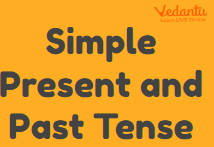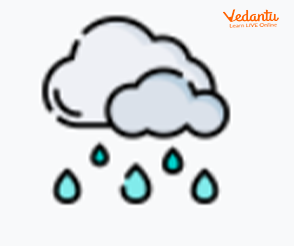




What Are Tenses? Simple Explanations with Student-Friendly Examples
The tense of a verb is the part of the verb that indicates when an action occurred and if it was completed. The tense of a verb is the shape it takes to express the action's timing. Different times are expressed using tenses. An action or event could have happened in the past, be happening now, or in the future. We can't comprehend tenses without first grasping the concept of verbs. It is here that we grasp the topic of the sentence and the time when it occurred by conjugating verbs which means changing the form of action according to the sentence.

Tenses
Types of Rules Tenses
The following chart of tenses shows rules to form and write sentences based on simple present tense rules and all other forms of tenses.
Simplifying Tenses with Examples
Present, past and future tenses are a simple way to understand the way to categorize the tense structure. However, it is also important to note that these tenses can be further divided into four other kinds, perfect, simple, perfect continuous and continuous. So for instance, Past tense can be simple past tense, past perfect continuous etc. Let us understand through examples the way to write, types of the present tense, past tense and future tense through the tenses chart.
Fun Practice Questions
A. Fill in the blanks with the correct form of a verb
1. He ____ football.
plays
played
will play
All of the above

Football
Ans: D. All of the above
2. The sun ______ us light and heat.
gives
gave
given
None of the above

Sun
Ans: A. gives
3. They ____ four months ago and are now married.
meet
met
will meet
are going to meet

Couple
Ans: B. met
Do it Yourself
A. Fill in the blanks with the correct form of a verb
1. I ____ the burger at the mall last evening.
eaten
eat
ate
eating

Burger
2. It ________ rain tomorrow.
will
is
will be
All of the above

Rain
3. Sara _____ home very late last night.
came
went
will go
Both A and B

A Girl
FAQs on Elementary Idea of Tenses: Understand English Verb Forms Easily
1. What is the elementary idea of tenses in English grammar?
The elementary idea of tenses is that they are a feature of verbs that show the time an action occurs. In English, we use different verb forms to indicate whether something is happening now (present), happened before (past), or will happen later (future). This is the most fundamental concept for making the meaning of a sentence clear.
2. What are the three main tenses and their four aspects?
The three main tenses in English correspond to the primary divisions of time. Each of these tenses has four aspects that provide more detail about the action's completion, duration, or timing.
- Main Tenses: Past, Present, and Future.
- Four Aspects: Simple (or Indefinite), Continuous (or Progressive), Perfect, and Perfect Continuous.
Combining these gives us the 12 basic tenses that are used in English grammar, such as Simple Present, Past Continuous, and Future Perfect.
3. Why is using the correct tense so important in communication?
Using the correct tense is crucial because it ensures clear communication and places events in the correct time frame, which prevents confusion. For example, saying “I will finish the project” instead of “I finished the project” completely changes whether the work is done or not. Proper tense usage is fundamental for conveying an accurate message, both in academic writing and everyday conversation.
4. What is the key difference between the Simple Past and the Present Perfect tense?
This is a common point of confusion. The key difference is the connection to the present moment.
- Simple Past (e.g., "I lost my keys yesterday") describes a completed action at a specific, finished time in the past. The event is over and separate from the present.
- Present Perfect (e.g., "I have lost my keys") describes a past action that has a result or relevance in the present. The focus is on the current situation: I don't have my keys now.
5. How can you easily understand the difference between the Simple, Continuous, and Perfect aspects?
Think of the aspects as adding a layer of detail about the nature of the action within a tense:
- Simple: Used for facts, habits, or single completed actions. Example: "He reads books." (A habit).
- Continuous: Describes an ongoing or unfinished action at a specific time. You will see an '-ing' verb form. Example: "He is reading a book." (Happening now).
- Perfect: Indicates an action's connection to another point in time, often a completed action with present results. You will see 'have/has/had' with a past participle. Example: "He has read the book." (He finished, and the result is relevant now).
6. Can you provide a simple example for each of the three main tenses?
Certainly. Here are examples showing how the verb 'work' changes to indicate time:
- Past Tense: She worked hard on the assignment. (The action is completed).
- Present Tense: She works at the library. (It's a current fact or routine).
- Future Tense: She will work on the weekend. (The action is yet to happen).
7. How do tenses help in telling a story or describing a sequence of events?
Tenses act as a timeline for a story. By shifting between different tenses, a writer can guide the reader through events logically. For instance, the Past Perfect Tense ("He had already eaten") is used to describe an action that happened before another past action ("when his mother called"). This sequencing creates a clear, structured, and engaging narrative, making it easy for the reader to follow the order of events.
8. What is an easy way to learn the verb forms for regular and irregular verbs?
There are simple patterns and methods to follow:
- For regular verbs, the past tense and past participle forms are almost always created by adding -d or -ed to the base verb (e.g., walk → walked, bake → baked).
- For irregular verbs, there is no set rule, and they must be memorised. A good trick is to group them by their change patterns (e.g., sing-sang-sung; bring-brought-brought) and practise using them in sentences to build familiarity.





















